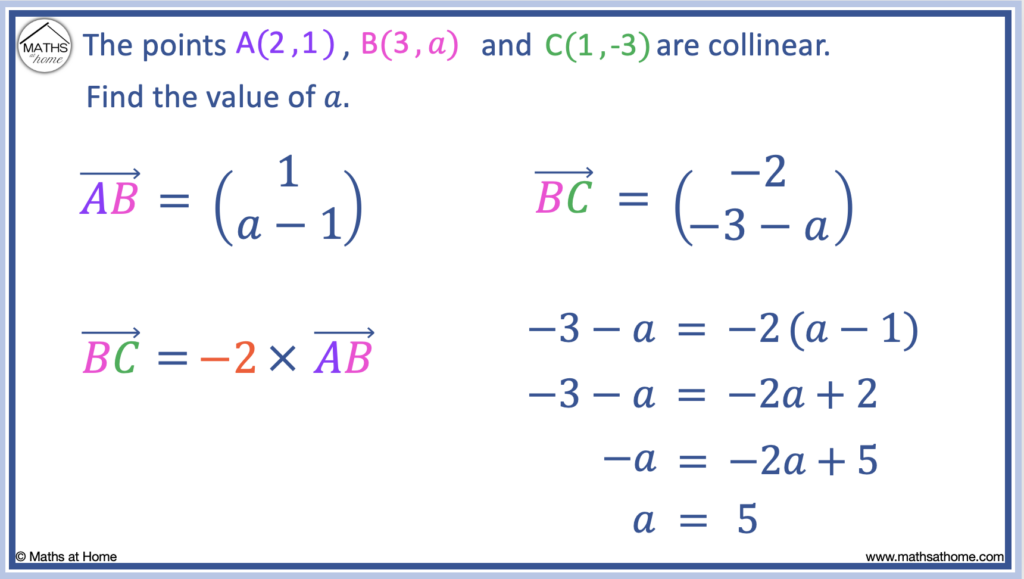Video Lesson: Collinear Vectors
What are Collinear Points?
Collinear points are points that lie on the same line. Points A, B and C are collinear if the vector AB is a multiple of vector BC. That is because if two vectors are parallel and share a common point, they are on the same line.
The points A, B and C shown below lie on the same line and therefore the points are collinear.
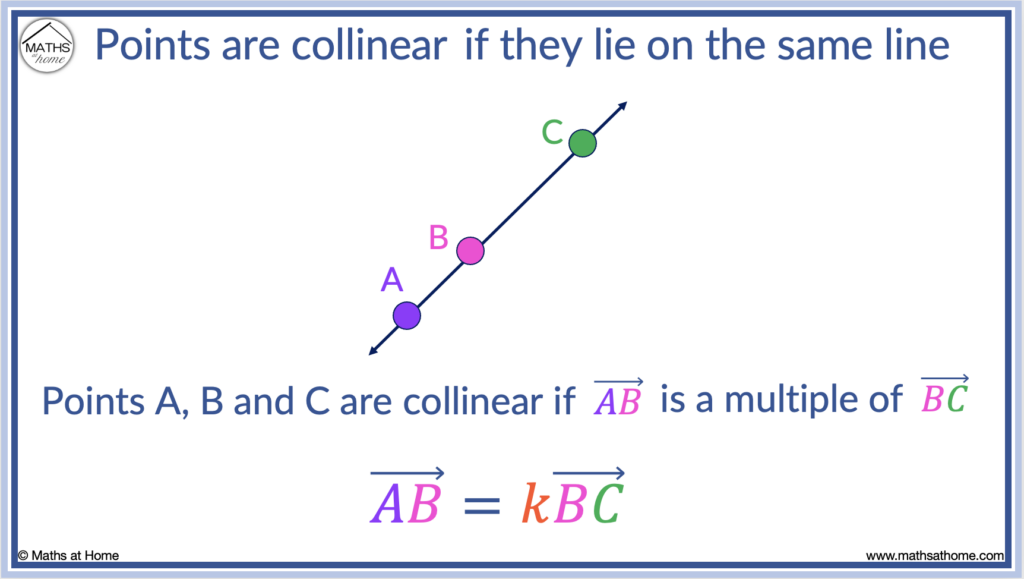
Parallel vectors are vectors that are oriented in the same direction.
If vectors are parallel, one vector is a multiple of the other vector.
For example, and
are parallel vectors since
.
It is important to note that parallel vectors are not always collinear.
For example, in the image below, is parallel to
but they do not share a common point. They are parallel but they are not on the same line.
If two vectors are parallel and share a common point, the points are on the same line and are therefore collinear.
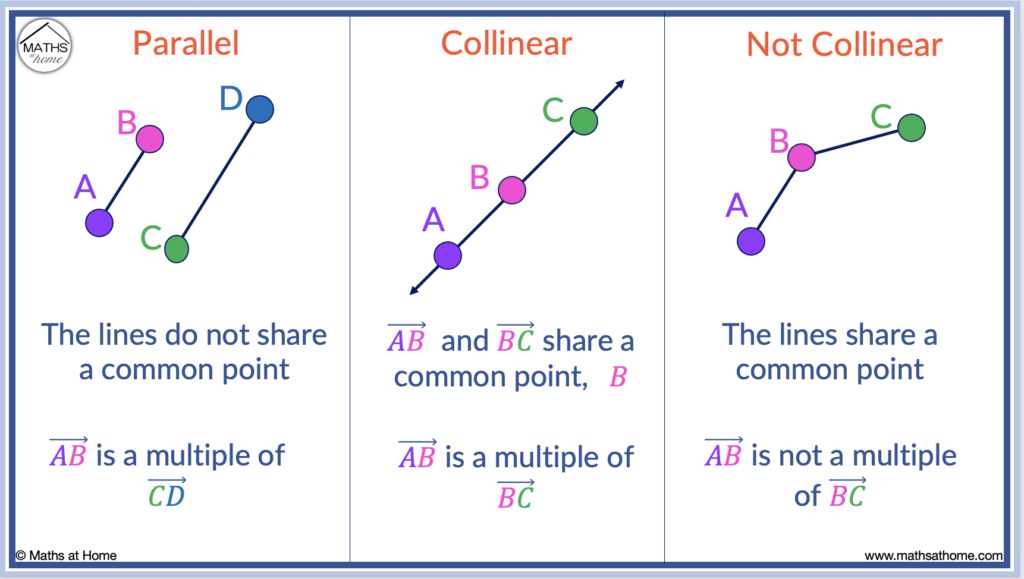
Points A, B and C are collinear if and
are parallel.
That is because both and
share a common point, B.
The vectors and
do not need to be the same magnitude to be collinear. Only their direction matters.
If the vectors and
are not parallel then the points are not collinear. This is shown in the rightmost image above.
Points in space are collinear if they lie on the same line. However, most applications of vectors involve free vectors, which do not have a position. Therefore the meaning of collinearity is different for vectors.
Vectors are collinear if they are parallel to the same line. Therefore collinear vectors are parallel to each other. That is, one vector is a multiple of the other.
How to Show Points are Collinear Using Vectors
To show that points A, B and C are collinear:
- Find the vectors AB and BC.
- If vector AB is a multiple of BC, the points are collinear.
- If vector AB is not a multiple of BC, the points are not collinear.
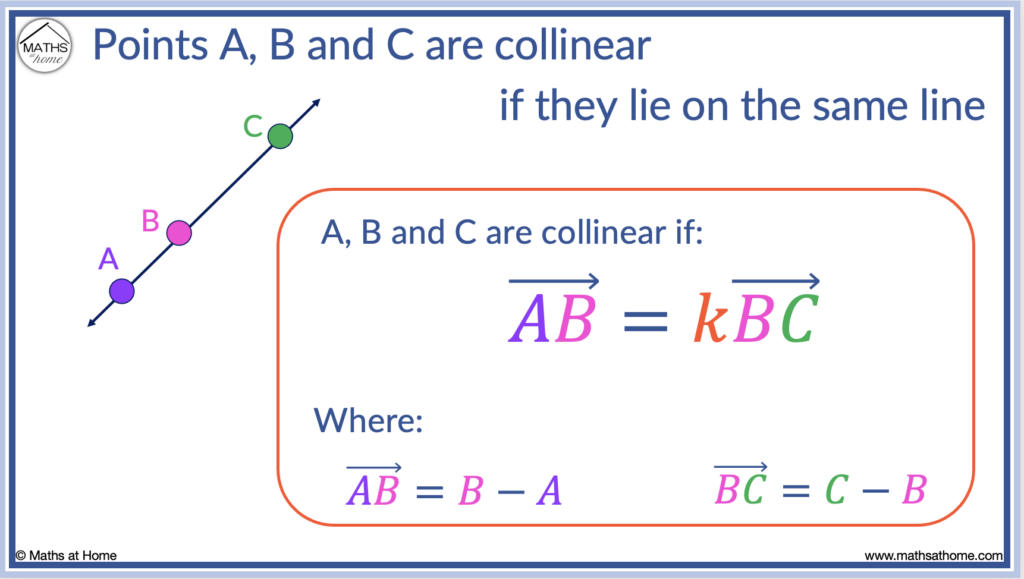
For example: Decide if the points A(2, 3), B(6, 7) and C(8, 9) are collinear.
Step 1. Find the vectors AB and BC
The vector is found by subtracting A from B.
The vector is found by subtracting B from C.
Step 2. If vector AB is a multiple of BC, the points are collinear
and
The values in vector are twice as large as those in vector
.
Therefore, .
is a multiple of
and so, the points are collinear.

Here is an example of points that are not collinear.
Decide if the points A(1, 4), B(2, 5) and C(6,3) are collinear.
Step 1. Find the vectors AB and BC
and so,
.
and so,
.
Step 2. If vector AB is a multiple of BC, the points are collinear
Now, the vector is not a multiple of
since the 𝑥 component of 1 was multiplied by 4 to obtain 4 but the y component of 1 was multiplied by -2 to make -2.
Therefore, the points are not collinear.
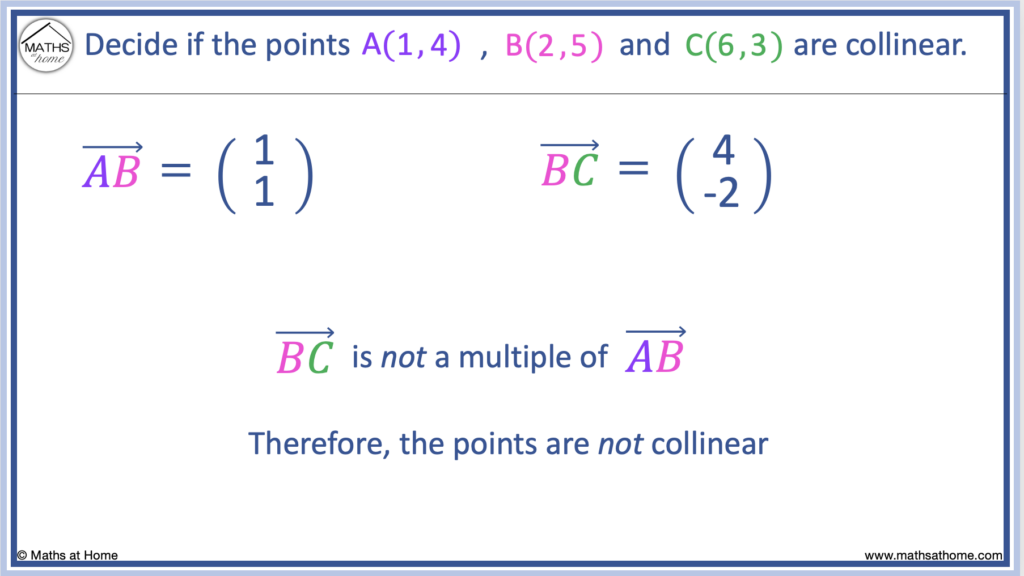
Formula for Determining Collinearity
The formula used to determine if points are collinear is AB = k BC. That is, if the vector AB is a multiple of the vector BC, the points A, B and C are collinear.
The formula for determining if vectors
and
are collinear.

Points A, B and C are collinear if the vectors and
are parallel.
Vectors are parallel if one vector is a multiple of the other.
That is written as .
How to Show Points are Collinear Using Distance
An alternative method for determining if points are collinear is to use the magnitude of the vectors between them.
The magnitude of a vector is its length.
For a given vector , its magnitude is given by
.
Points A, B and C are collinear if the magnitude of the vector AB plus the magnitude of vector BC is equal to the magnitude of vector AC. The formula for determining if points are collinear is |AB| + |BC| = |AC|.
The formula to show points are collinear using magnitudes of vectors

If the distance from A to B plus the distance from B to C is equal to the distance from A to C, the points must be in a line.
If the points are not in a line, the distance from A to B plus the distance from B to C will always be greater than the distance from A to C.
For example, show that the points A(4, -3), B(7, 1) and C(10, 5) are collinear using the distance formula.
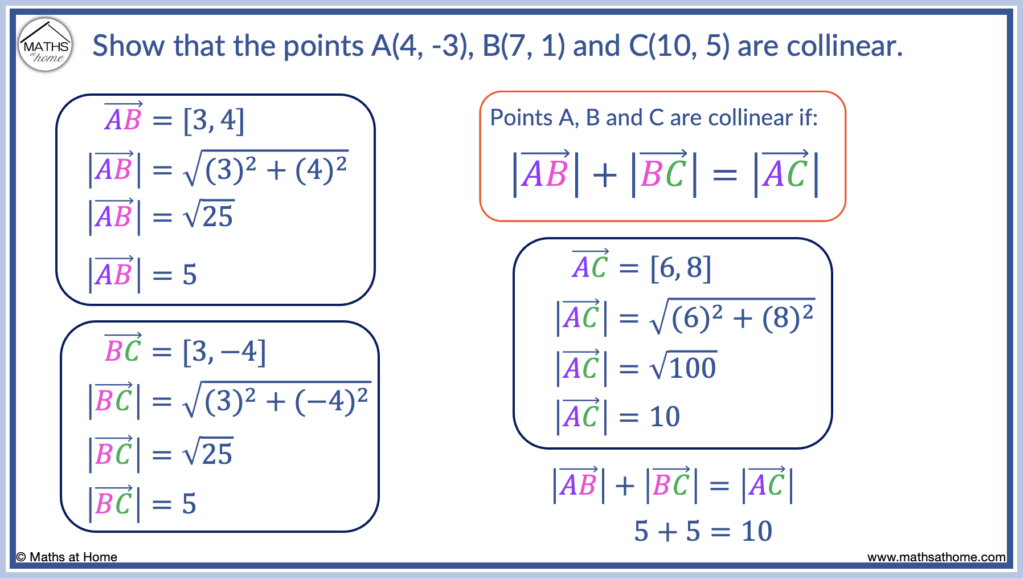
The points A, B and C are collinear if .
To show the points are collinear, we will show that this statement is true.
and therefore
.
.
.
Therefore since 5 + 5 = 10, and so, the points are collinear.
How to Prove that Vectors are Collinear
Two vectors between points are collinear if their cross product is equal to zero. For example, the vector AB = [5, 5] and the vector BC = [-3, -3]. Their cross product is equal to zero and they are collinear.
Considering the points A(-1, 1), B(4, 6) and C(1, 3), show that they are collinear.
We first find the vectors and
.
We then find their cross product using the formula .
.
If the cross product of two vectors is equal to zero, the points they pass through are collinear.
Therefore, these points are collinear.
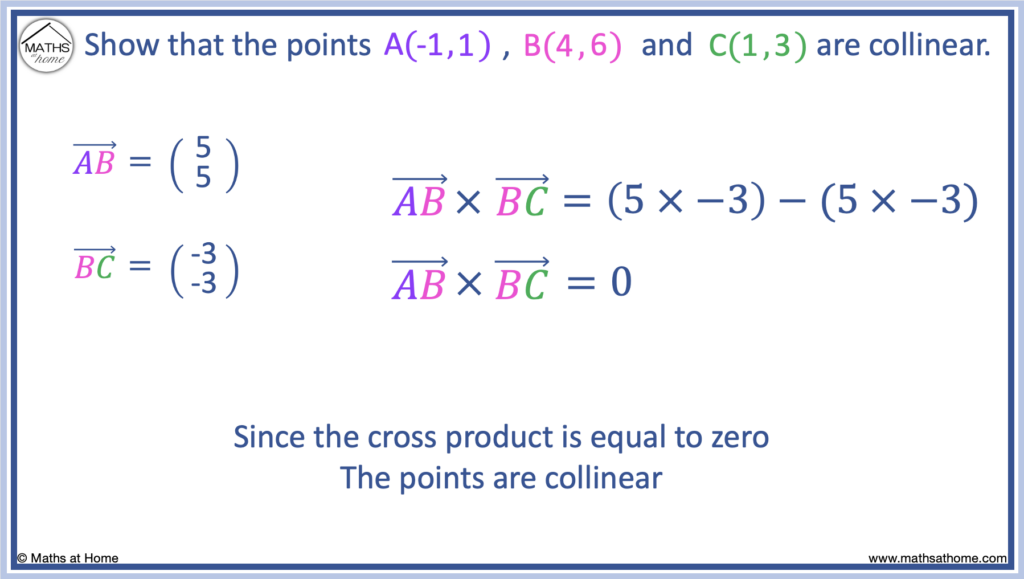
How to Show that Points are Collinear in 3D
The 3 dimensional points A, B and C are collinear if the vector AB is a multiple of the vector BC. For example if the vector AB is [2, -3, -1] and the vector BC is [-6, 9, 3], the points are collinear because the vector BC is equal to the vector AB multiplied by -3.
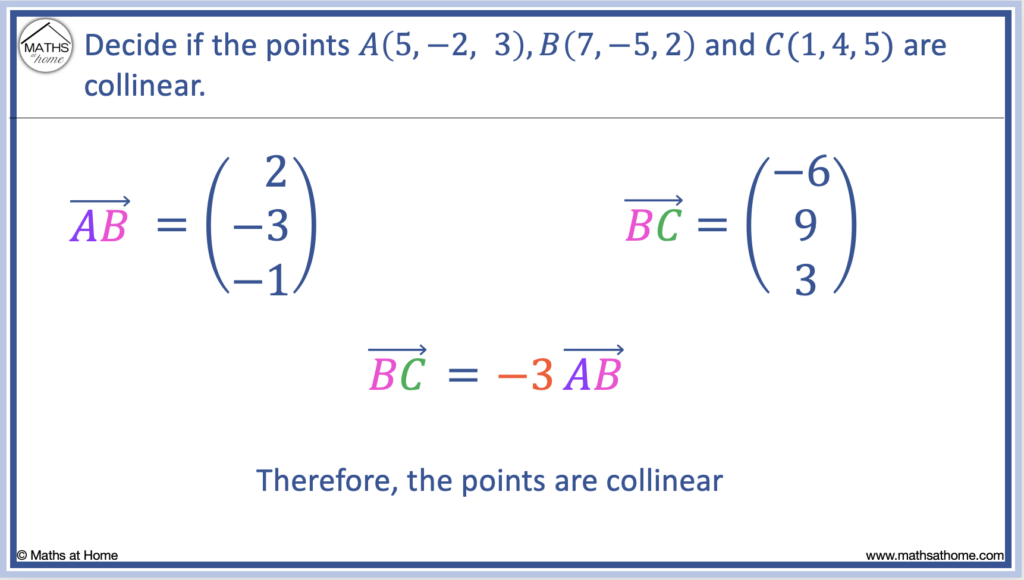
The vector is found by subtracting the point A from the point B.
The vector is found by subtracting the point B from the point C.
Now .
Therefore the points are collinear.
Find the Value for Which the Points are Collinear
To find a missing coordinate given that the points A, B and C are collinear:
- Find vectors AB and BC in terms of the missing value.
- Write vector AB as a multiple of the vector BC.
- Solve the resulting equation for the unknown coordinate.
For example, the points A(2, 1), B(3, a) and C(1, -3) are collinear. Find the value of ‘a’.
We first find the vector by subtracting vector A from vector B.
Then we find vector by subtracting vector B from vector C.
.
By comparing the first component of with the first component of
, we can see that
.
Therefore, we can write the equation for the second component.
We now solve this for a.
.
